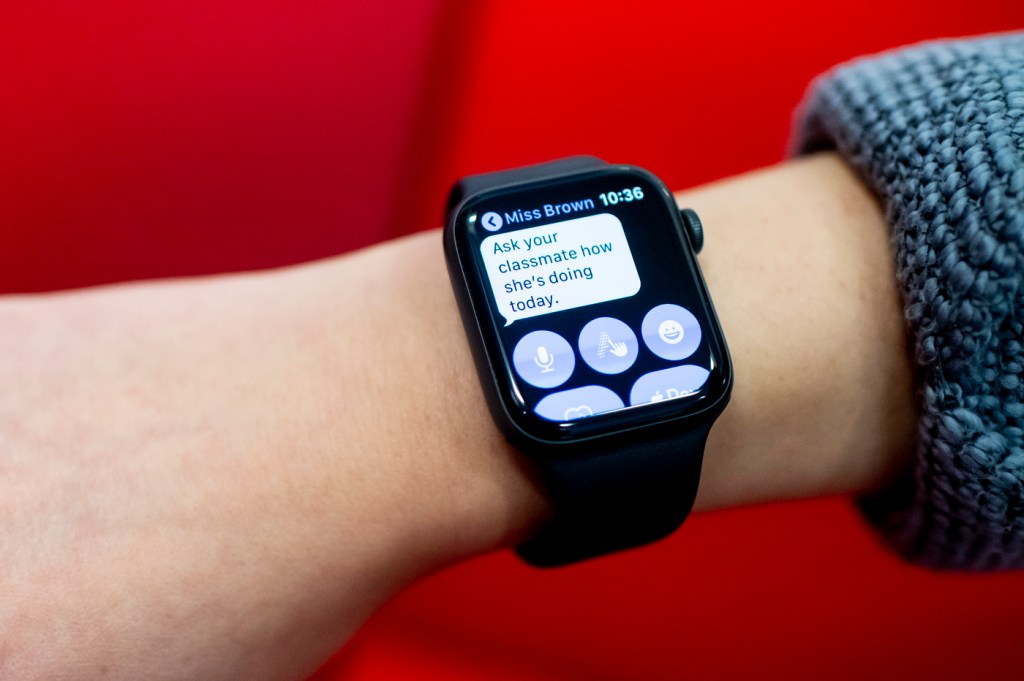Students with autism get a new tool for independence: A smartwatch

For students with autism, receiving extra help in school is often crucial to their academic success. But fitting in and feeling accepted is equally important, especially in the classroom.
Ralf Schlosser, a professor in the Department of Communication Sciences and Disorders at Northeastern, has developed a series of new teaching techniques to help students with autism learn alongside neurotypical classmates without drawing attention to themselves by using an unsuspecting piece of technology—a smartwatch.
“We’re trying to repurpose technology that already exists on the market,” says Schlosser. “Often these kids have special technology that makes them stand out. But if they can use something that other kids have, like an Apple Watch, it’s less stigmatizing.”

Ralf Schlosser, a professor in the department of communication sciences and disorders at Northeastern, has developed a series of new teaching techniques using smartwatches to help students with autism learn alongside neurotypical classmates. Photo by Ruby Wallau/Northeastern University
For students who need extra guidance, a text message can be sent to the watch to give them special directions. When directions come in from the teacher, the watch vibrates, alerting the student to the task at hand while remaining discreet.
“This allows students to be more independent than if a teaching aide is hovering over them,” Schlosser says.
The watches can also be used to facilitate social interactions. For example, during lunchtime, teachers can prompt students with autism to make conversation with their classmates—a cue that might not occur naturally to them.
Schlosser and his team filmed an example of this technique. To test whether the smartwatch commands would work, a teacher sent a text message to her autistic student saying, “Ask your classmate how she’s doing today.”
The first time the prompt was sent, the student with autism repeated that whole phrase, including the command. After the teacher explained a few times that she meant for the student to simply ask the question, the student was able follow the prompt correctly.
Early in his research, Schlosser wondered whether children with autism would be able to tolerate wearing a watch, since many people with autism are sensitive to certain physical stimuli.
“Some people with autism, they have trouble wearing hats or glasses, for example,” Schlosser explains. “But the watch wasn’t a problem.”
In the future, Schlosser envisions the use of similar technology to help people with autism beyond just the classroom. For example, during a job interview, if a person with autism has trouble maintaining eye contact or remembering other social cues, a reminder could inconspicuously be sent to the watch to keep that person on track.
Schlosser also hopes that eventually his team, including Howard Shane, director of the Autism Language Program at Boston Children’s Hospital, can pair with Northeastern professor Matthew Goodwin, who is working on a similar project to help people with autism.
Goodwin’s team is developing a wrist-worn device that monitors physiological changes that precede a violent outburst, a reaction some people with autism have when they become overwhelmed.
To anticipate and prevent these outbursts, the device alerts caretakers to these physiological changes—increased heart rate, perspiration, skin temperature, and arm movement—granting the caretakers enough time to intervene and calm the person down.
“Right now, smartwatches don’t have the kind of sensors that Matthew is working with,” Schlosser says. “But I hope that one day we could combine these two approaches. If we could monitor for increased heart rate, for example, perhaps we could use our techniques of communication or visual support to calm a person down.”
For media inquiries, please contact Marirose Sartoretto at m.sartoretto@northeastern.edu or 617-373-5718.





